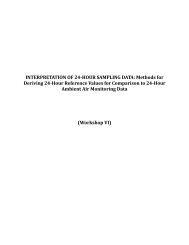Appendices - Alliance for Risk Assessment
Appendices - Alliance for Risk Assessment
Appendices - Alliance for Risk Assessment
You also want an ePaper? Increase the reach of your titles
YUMPU automatically turns print PDFs into web optimized ePapers that Google loves.
lacking, providing the air concentration interval corresponding to the lowest exposure at which<br />
increased risk was observed as well as a 10-3 excess risk level <strong>for</strong> cancer effect levels).<br />
3. Please comment on the usefulness of providing in<strong>for</strong>mation on effect levels or effect level<br />
intervals to understand potential health effects when health-protective reference values are exceeded.<br />
4. The procedures <strong>for</strong> developing effect levels that are predictive do not include the application of<br />
uncertainty factors (UFs) because when UFs are applied, it often produces an unknown effect on the<br />
probability of the response observed at the POD. For example, if a UF of 10 is applied <strong>for</strong><br />
intrahuman variability and true (but unknown) human variability <strong>for</strong> the chemical and endpoint is<br />
only around 3, the excess UF may result in a value that actually represents a NOAEL instead of an<br />
effects level. TCEQ’s goal is to estimate human effects levels with as high of a degree of confidence<br />
as possible that effects would indeed occur in some individuals, as opposed to speculating about how<br />
low an effects level could be in the absence of dose-response data in sensitive subpopulations.<br />
Comment on the “meaning” or definition of an effect level if central tendency values of the<br />
distribution of UFH and UFA are applied to effect levels





